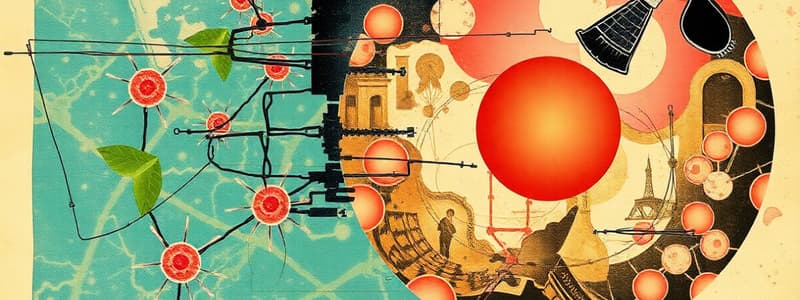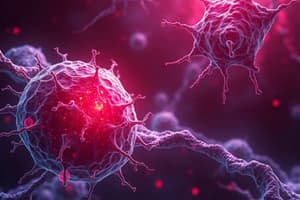Podcast
Questions and Answers
What is one of the consequences of IDH mutations in metabolism?
What is one of the consequences of IDH mutations in metabolism?
- Decrease in glutamine utilization
- Inhibition of aerobic glycolysis
- Increase in succinate levels (correct)
- Increase in 2-ketoglutarate levels
Which oncometabolite is associated with IDH mutations in the Krebs cycle?
Which oncometabolite is associated with IDH mutations in the Krebs cycle?
- Alpha-ketoglutarate
- Succinate (correct)
- Malate
- Fumarate
How does the Warburg effect primarily influence cancer cell metabolism?
How does the Warburg effect primarily influence cancer cell metabolism?
- By promoting anaerobic respiration exclusively
- By enhancing oxidative phosphorylation
- By increasing oxygen consumption
- By favoring aerobic glycolysis as a carbon source (correct)
What role do IDH mutations play in immune evasion during cancer progression?
What role do IDH mutations play in immune evasion during cancer progression?
What is an effect of increased levels of oncometabolites such as fumarate and succinate in tumor environments?
What is an effect of increased levels of oncometabolites such as fumarate and succinate in tumor environments?
What role does glutamine play in cellular metabolism?
What role does glutamine play in cellular metabolism?
Which metabolic pathway is directly influenced by glutamine through deamination reactions?
Which metabolic pathway is directly influenced by glutamine through deamination reactions?
What is anaplerosis primarily associated with in cellular processes?
What is anaplerosis primarily associated with in cellular processes?
Which of the following is NOT a method of regulating intracellular pH in hypoxic cells?
Which of the following is NOT a method of regulating intracellular pH in hypoxic cells?
What is the primary consequence of impaired carbonic anhydrase activity in xenograft tumors?
What is the primary consequence of impaired carbonic anhydrase activity in xenograft tumors?
Which amino acid is highlighted in its relationship with glutamine in cellular uptake?
Which amino acid is highlighted in its relationship with glutamine in cellular uptake?
In cancer cell metabolism, what is primarily driving the Warburg effect?
In cancer cell metabolism, what is primarily driving the Warburg effect?
What advantage does aerobic glycolysis provide to cancer cells?
What advantage does aerobic glycolysis provide to cancer cells?
What is the primary characteristic of the Warburg effect in cancer cells?
What is the primary characteristic of the Warburg effect in cancer cells?
Which enzyme is critical in controlling glycolytic flux and is often overexpressed in tumors?
Which enzyme is critical in controlling glycolytic flux and is often overexpressed in tumors?
How does lactate contribute to the metabolic environment of cancer cells in low-glucose conditions?
How does lactate contribute to the metabolic environment of cancer cells in low-glucose conditions?
What role does extracellular acidity play in immune evasion by cancer cells?
What role does extracellular acidity play in immune evasion by cancer cells?
Which mutation is most commonly associated with gliomas?
Which mutation is most commonly associated with gliomas?
What is a significant outcome of the bidirectionality of MCT1 transport and LDHA activity in tumors?
What is a significant outcome of the bidirectionality of MCT1 transport and LDHA activity in tumors?
What aspect of cellular metabolism is described by the term 'fetal metabolism' in cancer cells?
What aspect of cellular metabolism is described by the term 'fetal metabolism' in cancer cells?
Which transcription factor is known to increase glucose uptake and glycolytic gene expression in cancer cells?
Which transcription factor is known to increase glucose uptake and glycolytic gene expression in cancer cells?
Flashcards
IDHmut
IDHmut
Mutated isocitrate dehydrogenase, leading to 2-ketoglutarate accumulation.
Oncometabolites
Oncometabolites
Metabolic intermediates accumulated due to mutations in Krebs cycle enzymes.
2-ketoglutarate (2-KG)
2-ketoglutarate (2-KG)
An oncometabolite; inhibits aKG-dependent dioxygenases.
HIF-hydroxylating PHDs
HIF-hydroxylating PHDs
Signup and view all the flashcards
Metabolic addiction (cancer)
Metabolic addiction (cancer)
Signup and view all the flashcards
Glutamine (Gln)
Glutamine (Gln)
Signup and view all the flashcards
Glutamine Anaplerosis
Glutamine Anaplerosis
Signup and view all the flashcards
PET-Gln Imaging
PET-Gln Imaging
Signup and view all the flashcards
Intracellular pH Regulation (hypoxia)
Intracellular pH Regulation (hypoxia)
Signup and view all the flashcards
Carbonic Anhydrase (CA9)
Carbonic Anhydrase (CA9)
Signup and view all the flashcards
Hypoxia
Hypoxia
Signup and view all the flashcards
HIF-1
HIF-1
Signup and view all the flashcards
Cancer Cell Metabolism
Cancer Cell Metabolism
Signup and view all the flashcards
Aerobic glycolysis in cancer
Aerobic glycolysis in cancer
Signup and view all the flashcards
Warburg Effect
Warburg Effect
Signup and view all the flashcards
Glucose Uptake in Cancer
Glucose Uptake in Cancer
Signup and view all the flashcards
Cancer cell metabolism-Biosynthesis
Cancer cell metabolism-Biosynthesis
Signup and view all the flashcards
PKM2 isoform
PKM2 isoform
Signup and view all the flashcards
HIF-1 and cancer
HIF-1 and cancer
Signup and view all the flashcards
Lactate as energy source in cancer
Lactate as energy source in cancer
Signup and view all the flashcards
Cancer and low pH
Cancer and low pH
Signup and view all the flashcards
Study Notes
Cancer Hallmarks
- Cancer development requires specific changes
- Eight hallmarks are highlighted:
- Self-sufficiency in growth signals.
- Insensitivity to growth inhibition.
- Immortalization.
- Evasion of death (apoptosis).
- Angiogenesis.
- Tissue invasion and metastasis.
- Metabolic reprogramming.
- Evasion of the immune system
Cancer Cell Viability and Blood Vessels
- Cancer cell viability varies with distance to blood vessels.
- Human melanoma cells were found to display a shorter survival distance (85 μm).
- Rat prostate cancer cells displayed a longer survival distance (110 μm).
- Images show different levels of cancer cell viability related to blood vessel proximity.
Visualization of Hypoxic Areas
- Hypoxic areas in tissue can be visualized using EF5 staining.
- The staining differentiates between blood capillaries (green) and hypoxic areas in the tissue (red).
- EF5 localization pinpoints hypoxic marker locations.
Nutrient Supply to Tumors
- Historically, tumors were thought to receive nutrients by pre-existing vessels dilating, but now more commonly thought of as having angiogenesis.
- Angiogenesis is critical for ongoing tumor growth and metastasis
- Tumour growth was compared in two separate areas of the eye and angiogenesis only appeared feasible in one area.
Cancer in Angiogenesis-Deficient Mice
- Tumors grew smaller absent angiogenesis.
- Angiogenesis supports tumor growth, and lack of it leads to reduced tumor size.
- Mice that lack the ability for angiogenesis were examined to see if tumours were impacted.
- The results were that tumours did not grow in mice without the ability to initiate angiogenesis.
- Tumour blood vessel growth was driven by VEGF upregulation.
Angiogenesis: Recruitment of Endothelial Cells
- Human endothelial cell precursors can be recruited from bone marrow, supporting angiogenesis.
- Transplanting nude mice with human hematopoietic tissue allows for visualization of human endothelial markers in the mice.
Mosaic Structure of Tumor Vessels & Metastasis
- Colon cancer cells were found within vessel walls.
- Tumor cell cells within tumor vessel walls are shed.
Mechanisms of Blood Vessel Formation
- Sprouting angiogenesis and vasculogenesis are mechanisms of blood vessel formation.
- Vascular mimicry and tumor cell EC differentiation are also involved.
- There are differences in blood vessel structure between normal and tumor tissue.
- Tumor vasculature is characterized by irregular shapes, dead ends, less stable structure and a more rigid matrix.
Hypoxia-Induced Transcription Responses
- HIF-1 and HIF-2 are transcription factors that respond to cellular hypoxia.
- Hypoxia-induced transcription responses result in changes in gene expression.
- HIF - hypoxia-inducible factors
- CA- carbonic anhydrase
- GLUT - glucose transporter
- VEGF - vascular endothelial growth factor
- HRE - hypoxia-responsive element
VHL Loss
- Loss of the VHL gene is common in renal cell carcinoma.
- VHL gene mutations are associated with specific syndromes such as von Hippel-Lindau syndrome.
- Loss of VHL leads to increased HIF2a.
- HIF2a is a target for therapeutics.
- VHL and HIF2a have important roles in certain types of cancer.
Oncogene-Driven Expression of Pro-Angiogenic Proteins
- Oncogenes can drive the expression of proteins that promote angiogenesis.
- Some oncogenes are implicated in the production/upregulation of angiogenic proteins.
- Other oncogenes are implicated in the downregulation of anti-angiogenic proteins.
- Various oncogenes have been identified and linked to effects on tumour angiogenesis or related factors.
Major Mechanisms Regulating HIF-1α/2α Levels
- O2 availability, protein synthesis, ROS-mediated inhibition of PHDs, and inhibition by oncometabolites are mechanisms for regulating the levels of HIF-1α/2α.
Hypoxic Gene Expression Signature in Tumors
- Certain tumor types tend to have increased HIF-1α levels.
- Some cancers have been shown to have increased tumour mortality when HIF-1α levels increased.
- Increased mortality is often associated with aggressive/prognostic signs.
Other Solutions to Tumor Hypoxia
- Tumors can spread through blood vessel systems.
- Tumors can invade surrounding tissue for oxygen/nutrients.
Rationale for Anti-Angiogenic Therapy
- Anti-angiogenic therapy avoids the need for new blood vessels in healthy tissues.
- Avoiding drug resistance is a key reason behind therapies that target angiogenesis.
- Many cancers rely on blood vessels for growth, and blocking angiogenesis may be effective.
Inhibitors of Angiogenesis: Clinical Tests
- Several angiogenesis inhibitors have been tested clinically, including Avastin, which is an anti-VEGF antibody.
Endothelial Cells as Targets of Radiation Therapy
- Some cancers have been found to have enhanced activity of acidic sphingomyelinase.
- Acidic sphingomyelinase appears to influence radiation response.
Antitumor Effects of Radiation
- Radiation can directly kill tumor cells or indirectly damage them by affecting nearby normal tissue.
Clinical Results with Anti-VEGF Therapy
- Anti-VEGF therapy sometimes only delays tumor growth, and may not ultimately improve survival.
- Combination therapy with chemotherapy may sometimes be more effective.
Can Tumor Angiogenesis Be Clinically Beneficial?
- Manipulating vasculature could be beneficial for delivering drugs and targeting tumors, as well as potentially improving tumour responses.
- Improved drug delivery, access to the immune system and less aggressive tumours could all be benefits to targeting or maintaining vasculature growth characteristics.
Anti-VEGF Therapy: Reducing Immunosuppression
- Anti-VEGF therapy can potentially improve CD8+ T cell activity by reducing immunosuppression, which potentially leads to better clinical treatment outcomes.
Cancer Hallmark: Metabolic Reprogramming
- Cancer cells often exhibit metabolic reprogramming to support their rapid growth.
- Normal human cells metabolize glucose utilizing oxidative phosphorilation.
- Many cancer cells utilize aerobic glycolysis, despite having adequate oxygen.
Warburg Effect: Key Metabolic Hallmark of Cancer
- Warburg Effect refers to the phenomenon whereby cancer cells prioritize aerobic glycolysis for rapid growth.
- Warburg Effect characteristics have been linked to cancer cell aggressive behaviour.
Metabolic Addiction of Cancer: High Glucose Usage
- Cancer cells typically rely significantly on glucose metabolism for their energy and biosynthetic needs.
- PET imaging shows high glucose usage by certain cancers.
Decreased Glucose Metabolism as a Measure of Clinical Response
- Decreased glucose metabolism can serve as an indicator of therapeutic response or progression in cancer patients, often tracked using imaging techniques which measure glucose usage.
Warburg Effect and Cancer Aggressiveness
- Warburg effect has been associated with various cancer types and is often associated with more aggressive cancer behavior.
Cancer Cells Have Constitutively Active Glycolysis
- Cancer cells show continuous and high glycolysis activity, even with adequate oxygen.
- Glucose metabolism is constitutive in cancer cells, even in the presence of oxygen.
Aerobic Glycolysis as a Growth Advantage
- Competition for resources, adaptation through changes of metabolic pathways, use of lactate in hypoxic conditions, immune escape and cellular invasiveness, are some of factors influencing continuous aerobic glycolysis in cancer cells.
Cancers Cells Are Biosynthetically Hungry
- Cancer cells are often insatiable and their rapid growth leads to requirements for high rates of biosynthesis for essential molecules, proteins and other building blocks.
- Cancer cells can demonstrate an increased metabolic requirement for various building blocks compared to healthy cells.
Control of Glycolytic Flux in Cancer
- PKM2 isoform is important for regulation of glycolytic flux in cancer cells.
- PKM2 functions to facilitate certain biochemical processes/transfer steps that support cancer cell growth.
Molecular Basis of the Warburg Effect
- Several factors, like HIF-1, and factors in pathways like AKT, MYC, and p53, have roles in influencing the Warburg effect.
Mutated Isocitrate Dehydrogenase (IDH) in Cancers
- Mutations in IDH can lead to accumulation of specific metabolites that can influence various cellular and biochemical processes.
- Several cancers have been associated with IDH mutations, including glioma, and AML.
Oncometabolites from Mutations in Krebs Cycle
- Mutations in Krebs cycle enzymes lead to abnormal/deleterious metabolites.
- These abnormal metabolites can promote cancer development or progression.
Metabolic Addiction of Cancer #2: Glutamine
- Glutamine plays a significant role in supporting cancer cell growth.
- High uptake, glutamine anaplerosis, role of glutamine in various metabolic pathways and its biosynthetic function are linked to tumour progression.
PET-Gln Imaging of Brain Tumors
- PET-Gln imaging is a technique used to aid in the visualization of brain tumors (gliomas).
Regulation of Intracellular pH in Hypoxic Cells
- Intracellular pH regulation is vital in hypoxic cells for managing the effects of metabolism, and can be linked to progression & aggressiveness of cancers.
Impaired Xenograft Tumor Growth w/out Carbonic Anhydrases
- Tumour growth was shown to be reduced when the activity of carbonic anhydrases was blocked/altered/reduced in cells.
Metabolism of Cancer Cells: Summary
- Cancer cells frequently utilize multiple metabolic pathways to support their growth requirements.
- Cancer cell metabolism has a few specific advantages, but also several disadvantages.
Studying That Suits You
Use AI to generate personalized quizzes and flashcards to suit your learning preferences.




